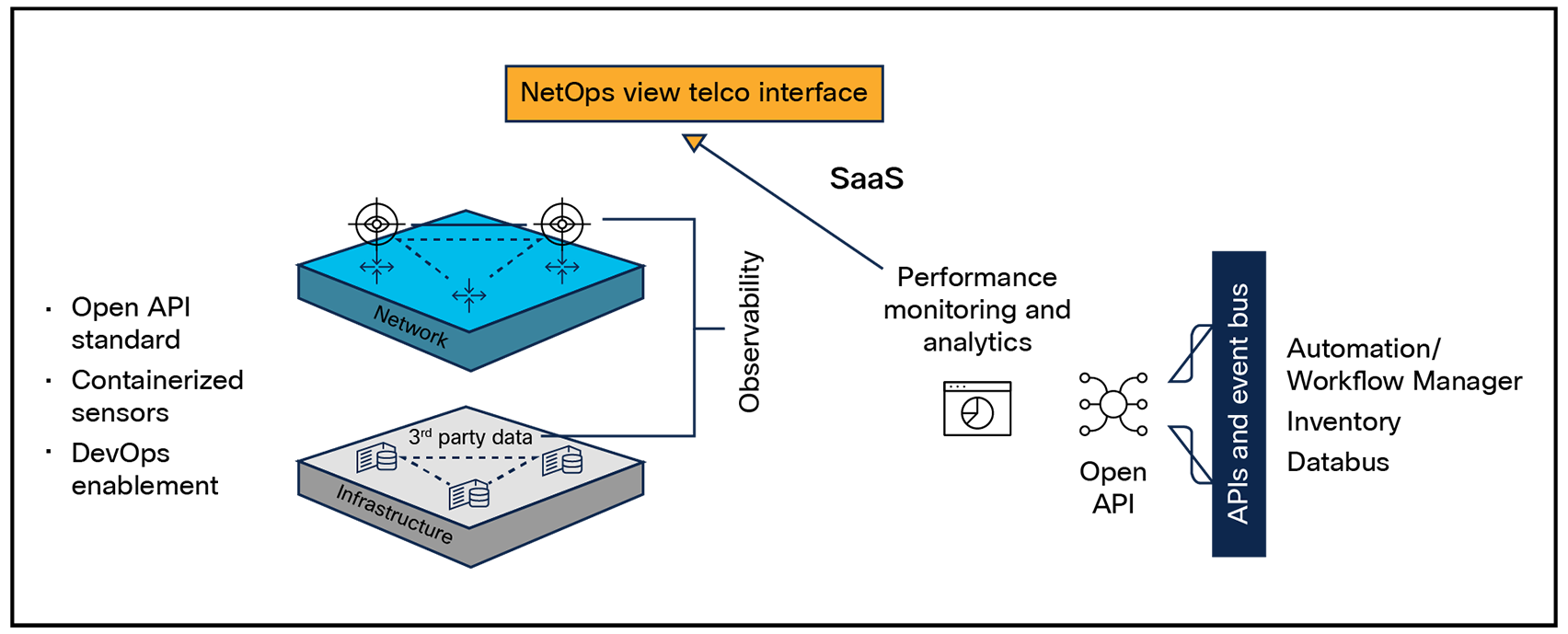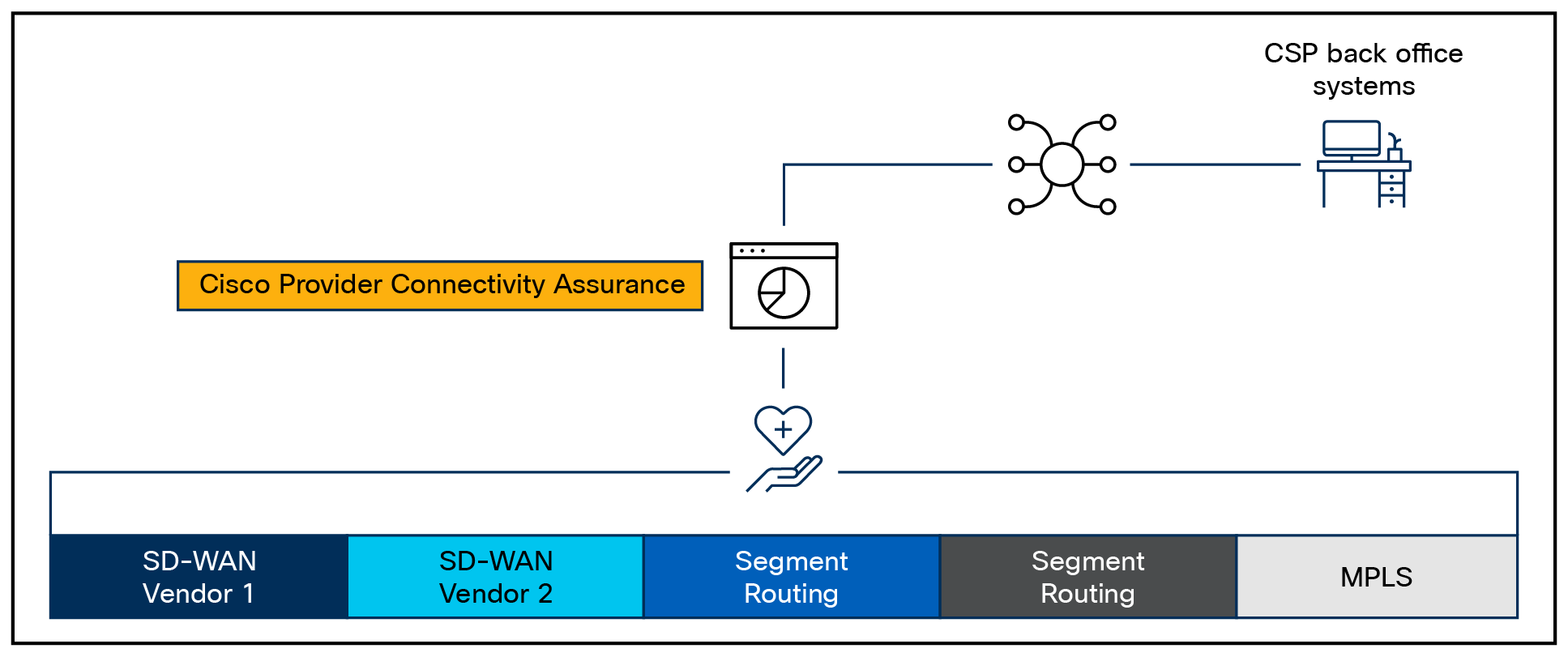Managed SD-WAN Services: Taking Multi-Vendor Performance to the Next Level Guide
Available Languages
Bias-Free Language
The documentation set for this product strives to use bias-free language. For the purposes of this documentation set, bias-free is defined as language that does not imply discrimination based on age, disability, gender, racial identity, ethnic identity, sexual orientation, socioeconomic status, and intersectionality. Exceptions may be present in the documentation due to language that is hardcoded in the user interfaces of the product software, language used based on RFP documentation, or language that is used by a referenced third-party product. Learn more about how Cisco is using Inclusive Language.
Managed service providers need to support multiple SD-WAN and security vendors and offer performance guarantees that stand out in the market.
Enterprises across industry verticals are adopting SD-WAN to connect branches and remote workers efficiently and securely to cloud applications. SD-WAN use cases are evolving as service providers plan to deploy SD-WAN edge software on universal Customer Premises Equipment (uCPE) to support additional Virtualized Network Functions (VNF) and cloud security applications.[1]
The key to driving successful managed SD-WAN services will be comprehensive network performance management across legacy and SD-WAN deployments, along with offering tiered service bundles with different features and Service Level Agreements (SLAs).
Read this guide to learn about:
● Managing the performance of multivendor SD-WAN and VNFs using a unified, SaaS platform powered by AI-enabled analytics cloud platform.
● Differentiating SD-WAN services with competitive SLAs and performance tiers.
● Efficiently troubleshooting performance issues with integrated underlay and overlay visibility.

The biggest barrier to delivering managed SD-WAN is clear: monitoring network performance comprehensively and in a correlated matter across hybrid SD-WAN, multiprotocol label switching, and IP VPNs. About two-thirds of respondents in a Heavy Reading survey on The Future of Managed SD-WAN Services cited monitoring network performance as a challenge, and 71% of the largest service providers, whose annual revenue exceeds $5 billion, indicated that this was a major issue.[2]
Visibility into performance
To gain visibility into both physical network performance and SD-WANs, service providers are deploying active performance monitoring on the transport layer and performance analytics to correlate events for customer reporting and to meet SLAs.
Correlation of underlay and overlay events
In fact, correlating events across the underlay and overlay for customer SLA reporting was the second biggest challenge cited by the largest CSPs in this study. Also in the top five challenges overall for CSPs are SLA verification and multilayer root cause analysis, which both benefit from effective network and application performance management.
Three biggest challenges in delivering SD-WAN as a managed service for CSPs:
● 66% Managing SD-WAN across multiple technologies and services.
● 62% SLA verification.
● 49% New service verification.
Open standards for automation
Managing multiple SD-WAN and security vendor products is easier when the offerings are based on open standards. Service providers will use automation to simplify performance monitoring of the underlay network, and, indeed, for all aspects of deploying and managing SD-WAN services.
Complete SD-WAN performance management
Variation among SD-WAN vendor offerings can lead to gaps and a lack of uniformity that create extra challenges for managed service providers. Unified management and a single open platform to manage SD-WAN overlay and the underlay can improve troubleshooting and resolve issues faster.
In addition, degradations and delays in the physical underlay network must be monitored, correlated, and analyzed for complete visibility and troubleshooting capabilities. An analytics-driven approach to SD-WAN network management can increase reliability by enabling anomaly detection and fault prediction. This also makes SD-WAN more efficient from an operations perspective and creates an opportunity to upsell premium SLAs and visibility.
Another way to add value is through third-party tools, including active performance monitoring on the transport layer, which can provide granular performance KPIs and an analytics and correlation engine that supports any time-series data. Performance monitoring solutions may also provide open APIs with flexible metadata to augment performance troubleshooting.
Look for a multivendor SD-WAN management tool that features:
● An open, multi-dimensional performance assurance platform that can unify multiple tools and help service providers successfully manage SD-WAN across multiple vendor services and underlay networks.
● A flexible architecture that allows service providers to leverage and support the integration of best-of-breed tools and systems, without significantly changing process behaviors or incurring major upfront costs.
● SLA verification, providing the visibility needed to differentiate commercial offers with SLA performance tiers and real-time SLA reporting through customer self-serve portals.
● Faster troubleshooting and easier automation by correlating events across the underlay and overlay network in a single platform that is application and transport aware.
● Support for DevOps with publicly available APIs, a standards-based architecture, cloud-native microservices, and support for flexible metadata and real-time data streaming.
Managed the performance of multiple SD-WAN vendors with unified visibility
A unified platform to manage all SD-WAN services, including virtual network functions deployed on demand on uCPEs in a cost-effective manner, is a growing requirement. Traditional monitoring tools can be monolithic and costly to evolve to meet new requirements, if they can change at all.
A cloud-native approach allows for easy ingestion of data from multiple sources and enables future scalability. It also provides the flexibility to manage any SD-WAN vendor, uCPE platform, CNF, or VNF without incurring major overhaul and costs. An open cloud architecture allows the data to be used flexibly by multiple groups and partners. This makes operations more agile in supporting the business to innovate and be faster to market with new services and features.
Automating processes is another benefit of open APIs and databus support: it allows for easy integration of performance data into closed-loop systems. DevSecOps engineers can develop new revenue and operational features using standards-based, cloud-native architecture with open APIs and support for flexible metadata and real-time data streaming. A flexible platform allows service providers to easily support best-of-breed vendors when acquiring new capabilities and features, without a major costly investment.

Combined overlay and underlay SD-WAN visibility for performance assurance
Addressing gaps in SD-WAN visibility
Service verification
The correlation of the overlay and underlay network needs to be instrumented in the service chain to close visibility gaps. Active test solutions can be deployed within the service chain to provide both overlay and underlay visibility.
Service activation testing must have zero impact on the end-to-end service performance. This also supports new service verification and zero-touch provisioning.
As SD-WAN is a single service that is delivered through different network technologies, the ability to coordinate and automate new service verification can be an issue when working across silos. The goal here is to be able to automate and remotely solve issues, avoiding costs associated with unnecessary truck rolls.

Cisco Provider Connectivity Assurance aggregates data to monitor SLAs across multiple service offerings
Challenge: Multiple SD-WAN offerings with multiple SLA monitoring tools.
Solution: Cisco Provider Connectivity Assurance (formerly Accedian Skylight) aggregates data for SLA monitoring of multiple services.
● Cloud-native, microservices-based approach that allows for easy ingestion from multiple sources in a single tool.
● Stateless, cloud-based architecture allows for future scalability without incurring major overhaul and costs.
● Open APIs and databus support enable easy integration into closed-loop systems.
● Open cloud architecture is flexible–data can be used by multiple groups.
Performance troubleshooting
A critical area for SD-WAN service providers is performance troubleshooting combined with understanding the relationships between different network domains. Events need to be monitored and correlated to quickly identify and fix issues when they arise (or before they arise with predictive analytics).
A multitiered performance assurance cloud platform can ingest third-party data using OpenMetrics standards and open APIs to correlate overlay and underlay visibility, and to provide KPI insight on both application and transport performance. The enriched KPI and performance data output can then be used by multiple systems including real-time streaming to the service orchestrator for closed-loop automation and issue resolution.
SLA verification and reporting
To meet SLAs, SD-WAN service providers need to verify performance and commit to competitive network availability, latency, and mean-time-to-resolution metrics. When SD-WAN is run across multiple network technologies, and even third-party access providers, it becomes a challenge to commit to a common SLA.
SLA reporting is required on a near real-time basis at a granular level (every millisecond) together with high-precision performance metrics and KPIs. With full visibility of the overlay and underlay network, service providers can effectively manage customer SLAs and differentiate services in a number of ways. These could include:
● Offering SLA performance tiers (gold, silver, and bronze).
● Improved real-time visibility on service performance through customer self-serve portals.
● Reduced errors in service provisioning by assuring services are delivered right the first time.
Automation
Automation is at the top of the list for many service providers, and key to delivering on that is having a platform that allows DevSecOps engineers to easily integrate into automation systems. One of the enablers of automation is the use of publicly available open APIs that allow for a workflow to be created.
To make it easier, no hard integration should be required to pass data between systems. A performance assurance platform should have the flexibility to fit into the automation system and take advantage of technologies, such as a databus, that allow easy integration into closed-loop systems. By using technologies like databus, actionable events can be leveraged by automation systems with the flexibility to adapt as new things are learned.
Cisco Provider Connectivity Assurance for SD-WAN assurance
The solution offers the following multilayered architecture featuring two key components: the assurance sensors and data layer and the performance analytics and visualization layer. These building blocks help service providers to deploy services faster, manage SD-WAN more effectively, and provide a superior end-user experience.
Provider Connectivity Assurance lightweight sensor layer is composed of a flexible combination of software agents, cloud-native sensors, hardware-assisted components, virtualized functions, and smart small-form pluggable hardware. The platform supports multitiered performance assurance and can be deployed wherever service providers need to fill gaps in their existing vendor solutions. This includes active test agents to gain visibility of the underlay network and passive sensors to monitor application performance.
Cisco Provider Connectivity Assurance combines data from all Assurance Sensors and third-party sources into a single view. It offers machine learning–powered alerts and rapid troubleshooting for network and application performance issues. Real-time intelligent monitoring also helps to predict issues and automate fixes. Raw data and KPIs can be enriched with metadata about SD-WAN locations, customers, equipment, transport network, and so on, to enhance insight.
Cisco Provider Connectivity Assurance provides:
● A cloud microservices platform that enables future scalability and flexibility to manage any SD-WAN vendor, uCPE platform, CNF or VNF.
● Multitiered performance assurance that ingests third-party data and supports OpenMetrics standards and open APIs.
● Underlay and overlay visibility to correlate data in a single open platform, with enriched data output that can be used by multiple systems.
● Industry-leading performance through service activation testing with zero impact on end-to-end service performance.
● SLA reporting featuring near real-time, granular (every millisecond) and high-precision performance metrics and KPIs to offer differentiated SLA tiers.
● Troubleshooting capabilities that include performance data analytics in real time for proactive monitoring and issue resolution.
● Automation features through open APIs and databus support, which allow for easy integration into closed-loop systems and create actionable events to automate issue resolution.

Unified, network-wide view of SD-WAN and other critical services with Cisco Provider Connectivity Assurance
Business benefits of Provider Connectivity Assurance for SD-WAN assurance
● Reduces operating expenses by consolidating multivendor SD-WAN management tools.
● Provides a single platform for underlay and overlay visibility and SLA KPI monitoring.
● Speeds troubleshooting with event correlation.
● Improves customer experience with “right the first time” service provisioning.
● Provides actionable insight and events for automated zero-touch operations.
● Use of patterns and baselining allow for ongoing improvements to the service.
Learn more at cisco.com